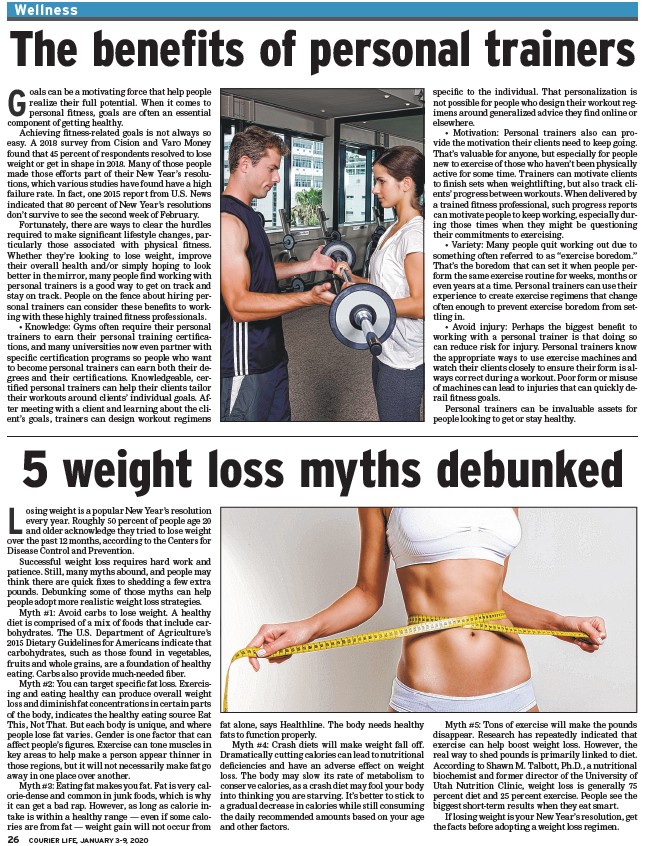
Wellness
The benefi ts of personal trainers
Goals can be a motivating force that help people
realize their full potential. When it comes to
personal fi tness, goals are often an essential
component of getting healthy.
Achieving fi tness-related goals is not always so
easy. A 2018 survey from Cision and Varo Money
found that 45 percent of respondents resolved to lose
weight or get in shape in 2018. Many of those people
made those efforts part of their New Year’s resolutions,
which various studies have found have a high
failure rate. In fact, one 2015 report from U.S. News
indicated that 80 percent of New Year’s resolutions
don’t survive to see the second week of February.
Fortunately, there are ways to clear the hurdles
required to make signifi cant lifestyle changes, particularly
those associated with physical fi tness.
Whether they’re looking to lose weight, improve
their overall health and/or simply hoping to look
better in the mirror, many people fi nd working with
personal trainers is a good way to get on track and
stay on track. People on the fence about hiring personal
trainers can consider these benefi ts to working
with these highly trained fi tness professionals.
• Knowledge: Gyms often require their personal
trainers to earn their personal training certifi cations,
and many universities now even partner with
specifi c certifi cation programs so people who want
to become personal trainers can earn both their degrees
and their certifi cations. Knowledgeable, certifi
ed personal trainers can help their clients tailor
their workouts around clients’ individual goals. After
meeting with a client and learning about the client’s
goals, trainers can design workout regimens
5 weight loss myths debunked
COURIER L 26 IFE, JANUARY 3-9, 2020
specifi c to the individual. That personalization is
not possible for people who design their workout regimens
around generalized advice they fi nd online or
elsewhere.
• Motivation: Personal trainers also can provide
the motivation their clients need to keep going.
That’s valuable for anyone, but especially for people
new to exercise of those who haven’t been physically
active for some time. Trainers can motivate clients
to fi nish sets when weightlifting, but also track clients’
progress between workouts. When delivered by
a trained fi tness professional, such progress reports
can motivate people to keep working, especially during
those times when they might be questioning
their commitments to exercising.
• Variety: Many people quit working out due to
something often referred to as “exercise boredom.”
That’s the boredom that can set it when people perform
the same exercise routine for weeks, months or
even years at a time. Personal trainers can use their
experience to create exercise regimens that change
often enough to prevent exercise boredom from settling
in.
• Avoid injury: Perhaps the biggest benefi t to
working with a personal trainer is that doing so
can reduce risk for injury. Personal trainers know
the appropriate ways to use exercise machines and
watch their clients closely to ensure their form is always
correct during a workout. Poor form or misuse
of machines can lead to injuries that can quickly derail
fi tness goals.
Personal trainers can be invaluable assets for
people looking to get or stay healthy.
Losing weight is a popular New Year’s resolution
every year. Roughly 50 percent of people age 20
and older acknowledge they tried to lose weight
over the past 12 months, according to the Centers for
Disease Control and Prevention.
Successful weight loss requires hard work and
patience. Still, many myths abound, and people may
think there are quick fi xes to shedding a few extra
pounds. Debunking some of those myths can help
people adopt more realistic weight loss strategies.
Myth #1: Avoid carbs to lose weight. A healthy
diet is comprised of a mix of foods that include carbohydrates.
The U.S. Department of Agriculture’s
2015 Dietary Guidelines for Americans indicate that
carbohydrates, such as those found in vegetables,
fruits and whole grains, are a foundation of healthy
eating. Carbs also provide much-needed fi ber.
Myth #2: You can target specifi c fat loss. Exercising
and eating healthy can produce overall weight
loss and diminish fat concentrations in certain parts
of the body, indicates the healthy eating source Eat
This, Not That. But each body is unique, and where
people lose fat varies. Gender is one factor that can
affect people’s fi gures. Exercise can tone muscles in
key areas to help make a person appear thinner in
those regions, but it will not necessarily make fat go
away in one place over another.
Myth #3: Eating fat makes you fat. Fat is very calorie
dense and common in junk foods, which is why
it can get a bad rap. However, as long as calorie intake
is within a healthy range — even if some calories
are from fat — weight gain will not occur from
fat alone, says Healthline. The body needs healthy
fats to function properly.
Myth #4: Crash diets will make weight fall off.
Dramatically cutting calories can lead to nutritional
defi ciencies and have an adverse effect on weight
loss. The body may slow its rate of metabolism to
conserve calories, as a crash diet may fool your body
into thinking you are starving. It’s better to stick to
a gradual decrease in calories while still consuming
the daily recommended amounts based on your age
and other factors.
Myth #5: Tons of exercise will make the pounds
disappear. Research has repeatedly indicated that
exercise can help boost weight loss. However, the
real way to shed pounds is primarily linked to diet.
According to Shawn M. Talbott, Ph.D., a nutritional
biochemist and former director of the University of
Utah Nutrition Clinic, weight loss is generally 75
percent diet and 25 percent exercise. People see the
biggest short-term results when they eat smart.
If losing weight is your New Year’s resolution, get
the facts before adopting a weight loss regimen.